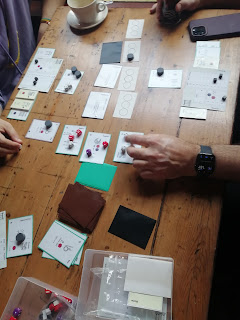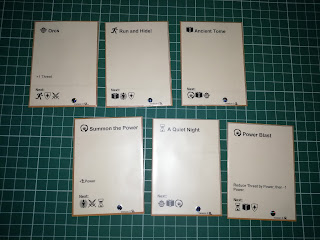Cast your mind back to the end of November and the beginning of December, and imagine a game designer who has spent the time since then not getting around to writing about what he did regarding game design that week. OK, scene set.
I actually had two playtests of my cooperative dice allocation game Sympolis over the course of that week: one was virtual, on Screentop.gg, and one physical, at Dragonmeet.
The first test ended in a loss for the players, with a small chance of a win on the final turn, but that chance really required great dice rolling at that point, which they did not have. There was a sense that another play could have a better result, but also some frustration at some aspects of the game (for example, the players were only able to generate one of the "wild" purple dice each round, due to an unlucky shuffle), and while I am pretty sure there were some decisions that could have improved the situation, the problem was mostly that the players were screwed by bad card draws and dice rolls and not by poor play. Besides that though, the biggest takeaway I had was how energised and proactive the players were: they self-organised quickly, discussing how to solve the problems presented by the game, and while there were frustrations (and not always in a good way), the vibe was really what I want for the game. Now I need to figure out how to bottle that!
I made a few small changes to the game in between, which effectively game a little additional resource and control at the start of the game, partly as one of the biggest problems with the virtual test was due to a dearth of resources (aka dice supply) and vulnerability to bad luck. And then there was a load of printing and cutting of cards to make an actual, physical prototype.
On to Dragonmeet. If you didn't know it, this is a nice, one day convention in London that was traditionally, and is still, largely based around tabletop roleplaying games, though there is a load of board game stuff there, including some great traders and a playtest area organised by Playtest UK - and every time I have been to the event, I have spent most of my time staffing the playtest area (with the exception of last year when there wasn't official playtesting, but a group of us got together and did some anyway).
 |
| I failed to take a photograph of play at Dragonmeet, so I faked one here with some red fabric and components laid out to plausibly represent play. |
Anyway, as well as staffing the playtesting area, I had a slot to test one of my games, and I had four great volunteers to test Sympolis. Once again, the players came out of the gates hard. They seemed to get their heads around the challenges pretty quickly and were actively and pretty intensely discussing their options, and we had pretty much the same apparent engagement from the players as in the previous test. Both groups were experienced board gamers, so maybe not fully representative players, but again I am very happy with this. As it turns out, the combination of the changes I made and the different random elements meant that this group won the game with a full round to spare. I think the two groups seemed to be making approximately equally good decisions (though they had different priorities), so it was probably the game setup and play state that made the difference.
A major note in the Dragonmeet play was that none of the players had problems with their wrath tracks, which record problems in the eyes of the gods and populace and provide one of the ways to lose the game. If your wrath tracks are low, it means that you can take bigger risks more confidently in the knowledge that misjudgement at least won't result in the end of the game, and thus you have an easier time of it. I had a useful discussion with one of the players afterwards, and we talked about mechanisms that compensate for things going too well; I have built up a number of elements that can mitigate "bad" luck, but now we have the opposite problem. One thought was that there could be some form of "push back" coming from having low scores on the wrath tracks: if the people are too happy, they get decadent and make bigger demands, for instance. I am pondering ways to approach this, but I like the idea and think it could work well.
One little aside... The current version of the game has a "wrath" card flipped at the end of every round, and these add an additional stressor to the game, which can make things get out of hand if players don't manage them effectively, and these also provide a timer for the game: the last of these cards flipped over means that the game is over. In general, I quite like how these work, but we run into the hoary problem of there being an upkeep action that isn't directly linked in to the game and the players aren't actually motivated to do. In the virtual test, one of the players was very good at being in charge of methodically flipping one of these each time, but in the physical test at Dragonmeet, it got forgotten (and needed reminding) a couple of times, and the rest of the time it was remembered as an afterthought. This is not ideal, and I need to figure out a way to make it so that the game requires the players to flip this card in order to proceed: maybe it actually triggers the gaining of resources, or something. Or, of course, I could find another way to ramp things up through the game: this particular mechanism isn't set in stone.
Aside number 2... With cooperative games there is a common concern about an effect that is often described as the "alpha player" or "quarterback" problem, which is where one player takes control of the game and can sometimes just tell other players what they should do, meaning that less confident players can find themselves just sitting at a table, watching someone else playing the game on their behalf. This seems to me to be a problem with a group dynamic more than anything, but game systems can mitigate this to make it so that an alpha player is less likely to emerge - or even, can't emerge. Examples include having restricted communication, or a real-time element to the game (Magic Maze is an example that has both of these). My inclination at the moment is to just not worry about it for this game. With a good group, it isn't an issue, and the energy at the table from having loose rules that give the players a lot of freedom appears to work well, and I suspect that any attempt to add a mitigation would damage that dynamic I like seeing. That said, I'm now wondering what the game would be like with limited player communication and a strict turn order; it would feel very different, but could be good. I'm staying focused on my current path, but this is a potential alternative for later.
Anyway, I just about managed to get this post in before the end of the year, so I'll wish you a happy Yule, Christmas, New Year, or whatever you celebrate at this time of the year, and all the best for 2024...

















